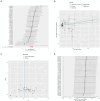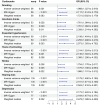Causal association between particulate matter 2.5 and Alzheimer's disease: a Mendelian randomization study
- PMID: 38873321
- PMCID: PMC11169690
- DOI: 10.3389/fpubh.2024.1343915
Causal association between particulate matter 2.5 and Alzheimer's disease: a Mendelian randomization study
Abstract
Background: Although epidemiological evidence implies a link between exposure to particulate matter (PM) and Alzheimer's disease (AD), establishing causality remains a complex endeavor. In the present study, we used Mendelian randomization (MR) as a robust analytical approach to explore the potential causal relationship between PM exposure and AD risk. We also explored the potential associations between PM exposure and other neurodegenerative diseases.
Methods: Drawing on extensive genome-wide association studies related to PM exposure, we identified the instrumental variables linked to individual susceptibility to PM. Using summary statistics from five distinct neurodegenerative diseases, we conducted two-sample MR analyses to gauge the causal impact of PM on the risk of developing these diseases. Sensitivity analyses were undertaken to evaluate the robustness of our findings. Additionally, we executed multivariable MR (MVMR) to validate the significant causal associations identified in the two-sample MR analyses, by adjusting for potential confounding risk factors.
Results: Our MR analysis identified a notable association between genetically predicted PM2.5 (PM with a diameter of 2.5 μm or less) exposure and an elevated risk of AD (odds ratio, 2.160; 95% confidence interval, 1.481 to 3.149; p < 0.001). A sensitivity analysis supported the robustness of the observed association, thus alleviating concerns related to pleiotropy. No discernible causal relationship was identified between PM and any other neurodegenerative diseases. MVMR analyses-adjusting for smoking, alcohol use, education, stroke, hearing loss, depression, and hypertension-confirmed a persistent causal relationship between PM2.5 and AD. Sensitivity analyses, including MR-Egger and weighted median analyses, also supported this causal association.
Conclusion: The present MR study provides evidence to support a plausible causal connection between PM2.5 exposure and AD. The results emphasize the importance of contemplating air quality interventions as a public health strategy for reducing AD risk.
Keywords: Alzheimer’s disease; Mendelian randomization; air pollution; neurodegenerative diseases; particulate matter.
Copyright © 2024 Dang, Li, Zhao, Li, Lu, Lu, Feng, Yang, Li, Tang, Wang, Jian, Wang, Zhang, Fan and Zhang.
Conflict of interest statement
The authors declare that the research was conducted in the absence of any commercial or financial relationships that could be construed as a potential conflict of interest.
Figures




Similar articles
-
Exploring the association between air pollution and Parkinson's disease or Alzheimer's disease: a Mendelian randomization study.Environ Sci Pollut Res Int. 2023 Dec;30(59):123939-123947. doi: 10.1007/s11356-023-31047-w. Epub 2023 Nov 23. Environ Sci Pollut Res Int. 2023. PMID: 37995032
-
A causal relationship between particulate matter 2.5 and obesity and its related indicators: a Mendelian randomization study of European ancestry.Front Public Health. 2024 Jun 14;12:1366838. doi: 10.3389/fpubh.2024.1366838. eCollection 2024. Front Public Health. 2024. PMID: 38947357 Free PMC article.
-
Causal relationships between genetically predicted particulate air pollutants and neurodegenerative diseases: A two-sample Mendelian randomization study.Ecotoxicol Environ Saf. 2024 Oct 1;284:116960. doi: 10.1016/j.ecoenv.2024.116960. Epub 2024 Aug 28. Ecotoxicol Environ Saf. 2024. PMID: 39208585
-
Evaluating the Causal Association Between Type 2 Diabetes and Alzheimer's Disease: A Two-Sample Mendelian Randomization Study.Biomedicines. 2025 Apr 30;13(5):1095. doi: 10.3390/biomedicines13051095. Biomedicines. 2025. PMID: 40426922 Free PMC article. Review.
-
Associations of environmental factors with neurodegeneration: An exposome-wide Mendelian randomization investigation.Ageing Res Rev. 2024 Mar;95:102254. doi: 10.1016/j.arr.2024.102254. Epub 2024 Feb 29. Ageing Res Rev. 2024. PMID: 38430933 Review.
Cited by
-
Factors Affecting Resilience and Prevention of Alzheimer's Disease and Related Dementias.Ann Neurol. 2024 Oct;96(4):633-649. doi: 10.1002/ana.27055. Epub 2024 Aug 17. Ann Neurol. 2024. PMID: 39152774 Review.
References
-
- World Alzheimer Report . Reducing Dementia Risk: Never too early, never too late; (2023).
-
- Khreis H, Bredell C, Wai Fung K, Hong L, Szybka M, Phillips V, et al. . Impact of long-term air pollution exposure on incidence of neurodegenerative diseases: a protocol for a systematic review and exposure-response meta-analysis. Environ Int. (2022) 170:107596. doi: 10.1016/j.envint.2022.107596, PMID: - DOI - PubMed
MeSH terms
Substances
LinkOut - more resources
Full Text Sources
Medical

